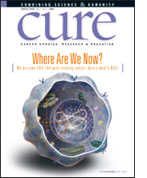Publication
Article
CURE
Knowing What Works
Author(s):
It didn’t take scientists long to realize no drug has a 100 percent response rate for any cancer, but now they’ve figured out why—variations in the genetic code of an individual patient or tumor can affect the response to treatment.
University
North Carolina
of
"Any drug we currently use for cancer is really a drug that needs to be individualized,” says Howard McLeod, PharmD, director of the two-year-old Institute for Pharmacogenomics and Individualized Therapy. “There are very few examples where the drug will work in even half of the patients in which it’s administered.”
Making headlines at this summer’s annual meeting of the American Society of Clinical Oncology was the announcement that colorectal cancer patients who had a mutated form of the KRAS gene in their tumors had little or no benefit from treatment with Erbitux (cetuximab). Assays to test for the KRAS mutation are now being used to determine whether a patient should receive Erbitux, and changes to clinical trial designs involving the drug have also been amended in the past several months.
Not everyone with the normal (wild-type) KRAS gene responds to Erbitux, and some cancers eventually progress—questions researchers are now tackling.
Besides mutated KRAS, other blockades exist to prevent certain drugs from working. Individual inherited variations in a breast cancer patient’s genetic code may affect how well tamoxifen works. Researchers have found that a small number of breast cancer patients who have a certain variation of the CYP2D6 gene do not metabolize tamoxifen -effectively. (Certain antidepressants that reduce hot flashes may inhibit the enzyme encoded by the CYP2D6 gene and lower metabolism even further.) While the CYP2D6 test is not used across the board, it may play a role in adjusting adjuvant breast cancer treatment.
One challenge in fully utilizing the potential of pharmacogenomics—the study of how individual genetic characteristics may predict one’s response to drugs—is that the large-scale data to identify useful markers do not exist. To solve that problem, researchers from the National Cancer Institute are taking blood samples from patients enrolled in its large trials to build up enough information to fully examine the effects of different genetic variations.
“For once we have the technology to do what we need to do in tumor material,” says McLeod. “So the issue really comes down to [getting tissue samples from] the large clinical cohorts.”
Recently, scientists have also discovered ways to measure response to treatment in less time. The FDG-PET (fluorodeoxyglucose-positron emission tomography) Lung and Lymphoma Projects use PET imaging to track the amount of radioactive sugars absorbed by the cancer cells before and after treatment. This creates a better method for scientists to determine if the treatment is shrinking the tumor over a much smaller timeframe than conventional imaging.






